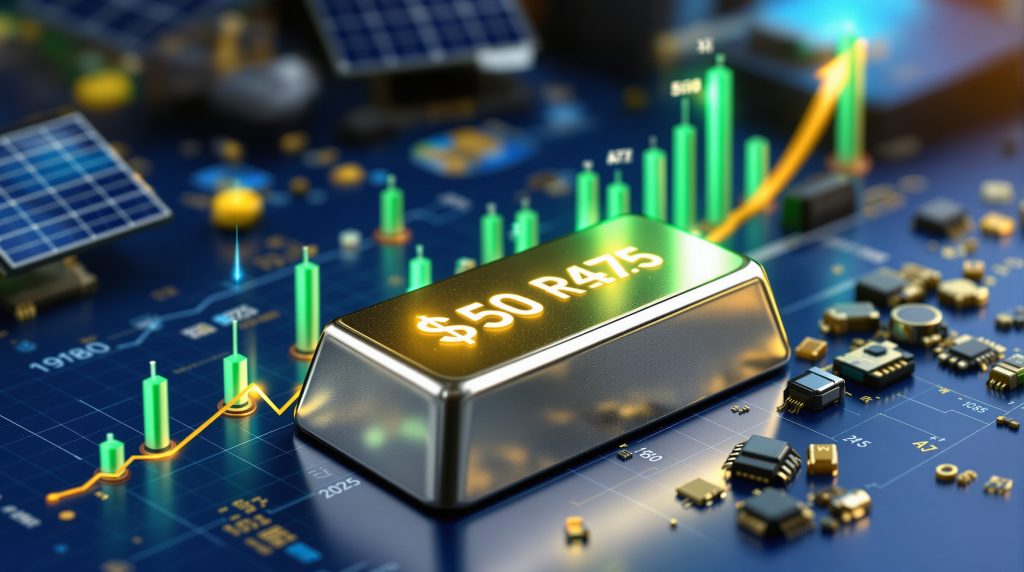The Remarkable Journey of Silver: Analyzing a Historic Price Rally
Silver has captured the attention of investors worldwide as it experiences a meteoric rise in value. With prices approaching the $47 per ounce mark as of early October, the precious metal is showcasing its potential for significant returns. This silver price surge represents nearly a 20% increase in just one month, with year-to-date gains exceeding 55% from its starting price near $29. The most dramatic gains have occurred during the third quarter, with September alone delivering an impressive 16.1% growth in value.
The current trajectory suggests silver may surpass the psychologically significant $50 threshold within weeks—a level it has approached but never successfully maintained in its modern trading history. This potential milestone has both long-term investors and market analysts closely monitoring silver's movements with heightened interest.
Key Price Milestones in the Current Rally
Silver's ascent has been marked by several notable achievements. The metal crossed the important $40 threshold in August, breached $45 in late September, and is now trading steadily above $47 with strong overnight gains frequently being recorded. These progressive price levels have built momentum as silver approaches its historic all-time high of $49.45 (spot price) established over four decades ago.
The overnight price movements have become particularly noteworthy, with traders in Western markets often waking to find silver has gained significant value during Asian trading hours—a pattern that highlights the global nature of this rally.
Silver's Historical Price Records: Context and Perspective
Understanding silver's current rally requires historical context. The metal's highest recorded spot price was $49.45 per ounce, established via the London Fix in January 1980. On that same day, silver futures contracts peaked slightly higher at $50.35 per ounce. The next significant challenge to this record came in April 2011, when spot prices reached $49.21—tantalizingly close to setting a new record before retreating.
With current prices in the $47-48 range, silver stands on the precipice of potentially making history by establishing a sustainable price above the $50 mark for the first time.
Inflation-Adjusted Historical Perspective
When adjusted for inflation, silver's historical peaks take on even greater significance. The 1980 high of $49.45 would equate to approximately $200 per ounce in today's dollars. Similarly, the 2011 peak of $49.21 would translate to roughly $70 per ounce in current terms.
This inflation-adjusted view reveals that despite the impressive nominal gains, current silver valuations between $45-50 remain approximately 50% below the inflation-adjusted 2011 peak. This suggests substantial upside potential remains when viewing the market through a historical lens adjusted for purchasing power.
Fundamental Factors Driving the Silver Rally
Several powerful fundamentals are converging to create ideal conditions for silver market squeeze analysis. Most notably, the market has experienced consecutive annual deficits, with estimates for the current year's shortfall exceeding 100 million ounces. This persistent imbalance between supply and demand has gradually tightened physical market conditions, reducing above-ground inventories available to satisfy growing consumption.
Mining production constraints have proven difficult to overcome, limiting the introduction of new supply even as prices have risen substantially. Mining operations face challenges including declining ore grades, regulatory hurdles, and infrastructure limitations that prevent rapid production increases despite more favorable economics.
Industrial Demand Acceleration
Unlike gold, silver's price is significantly influenced by its industrial applications, which account for over 50% of total demand according to data from industry analysts. This demand has accelerated in recent years, driven by several key sectors:
• Green energy technologies, particularly solar panel manufacturing, consume substantial silver inputs. Each photovoltaic panel requires silver paste for electrical contacts, with the average solar installation using approximately 20 grams of silver.
• Electronics and electrical applications continue to expand as consumers and businesses adopt more connected devices and electric vehicles.
• Medical applications have grown as silver's antimicrobial properties find new uses in healthcare settings.
• Advanced manufacturing technologies increasingly rely on silver's unique physical and chemical properties.
This diversified industrial demand provides a sturdy foundation for price support even during periods of financial market turbulence.
Investment and Monetary Demand
Beyond its industrial applications, silver continues to attract significant investment interest:
• Safe-haven buying has intensified amid global economic uncertainties and geopolitical tensions.
• Exchange-traded fund (ETF) inflows demonstrate renewed institutional and retail investor interest.
• Physical bullion purchases have remained robust, with dealers frequently reporting premium increases for popular products during periods of high demand.
• Silver's historical correlation with gold's upward momentum has strengthened in recent months, with silver typically exhibiting greater percentage gains during precious metals bull markets.
Global Economic Conditions Supporting Silver's Rise
The current macroeconomic landscape provides fertile ground for precious metals performance. Market expectations increasingly favor Federal Reserve rate cuts as economic data points to potential slowdown concerns. This shift toward more accommodative monetary policy globally reduces the opportunity cost of holding non-yielding assets like silver.
Declining real interest rates (nominal rates minus inflation) historically correlate strongly with precious metals performance. When real rates turn negative or trend lower, investors often increase allocations to hard assets that can preserve purchasing power.
Geopolitical Risk Factors
Several international developments have amplified silver's appeal as a store of value:
• Ongoing conflicts in multiple regions have highlighted geopolitical instability.
• Government funding uncertainties in major economies have raised questions about long-term fiscal sustainability.
• International trade tensions and tariff disputes continue to disrupt global supply chains.
• Critical mineral supply security has become a strategic concern for many nations, particularly for materials essential to technology and defense applications.
These factors collectively contribute to an environment where portfolio hedging becomes increasingly attractive, benefiting silver's investment case.
Why This Silver Rally May Differ From Previous Attempts at $50
Market structure has evolved significantly since silver's previous approaches to the $50 threshold. Price discovery mechanisms have become more decentralized, with COMEX no longer maintaining the dominant position it once held in determining global silver prices.
The growing importance of Asian exchanges—particularly Shanghai—has created alternative venues for price discovery. This geographical diversification means overnight price movements increasingly originate in Asian markets rather than being primarily dictated by Western trading sessions.
Diversified Investment Vehicles
Today's silver market offers significantly more access points for investors compared to previous cycles:
• Exchange-traded funds provide easier market access than was available in previous decades, allowing mainstream investors to gain exposure without the complexities of futures contracts or physical storage.
• A robust physical bullion market with global reach connects buyers and sellers across borders more efficiently than in previous eras.
• Over-the-counter derivatives offer alternative exposure methods for institutional investors.
• Foreign exchanges provide near-continuous trading opportunities, creating a more liquid and accessible global marketplace.
Historical Market Intervention Analysis
Previous approaches to the $50 level were met with significant market interventions:
• In 1980, COMEX and the Chicago Board of Trade implemented "Silver Rule 7" which imposed liquidation-only trading restrictions. This policy prevented traders from opening new long positions while dramatically raising margin requirements, effectively forcing selling pressure.
• In 2011, CME Group (which operates COMEX) raised silver margin requirements by 84% within a two-week period. This rapid increase created selling pressure as leveraged traders were forced to reduce positions, halting the rally just shy of the $50 mark.
• For 2025, the potential effectiveness of similar interventions appears diminished due to the more fragmented global market structure. While Western exchanges could still implement rule changes, Shanghai prices often trade at a premium to COMEX, and many rallies now begin during Asian trading sessions.
This evolution suggests the monopolistic pricing power once exercised by Western exchanges has eroded significantly, potentially allowing silver to break through previous resistance levels.
Expert Price Projections for Silver
Market analysts have produced a range of forecasts for silver's future price trajectory, with considerable variation in their outlook based on differing methodologies and assumptions.
Short-Term Price Targets (Next 3-6 Months)
The consensus view among technical analysts suggests silver will likely breach the $50 psychological barrier in the near term. Several factors support this outlook:
• Technical indicators show limited resistance above current levels once the previous high is cleared.
• Momentum measurements including Relative Strength Index (RSI) and Moving Average Convergence Divergence (MACD) suggest continued strength despite near-term overbought conditions.
• Seasonal patterns typically favor precious metals through year-end, with Q4 historically showing positive performance.
Medium-Term Outlook (6-18 Months)
Looking further ahead, analyst projections range from $55 to $75 per ounce based on fundamental supply-demand modeling. These forecasts incorporate several key assumptions:
• The supply deficit is expected to persist through 2026, maintaining pressure on available inventories.
• Industrial demand forecasts indicate continued growth, particularly in green energy applications.
• Investment demand is projected to accelerate as new price records generate additional media coverage and public awareness.
Long-Term Potential (Beyond 2026)
Some market observers suggest more ambitious targets, with projections reaching toward $100 per ounce in an extended bull market scenario. These longer-range forecasts consider:
• Structural supply constraints that are expected to continue as easily accessible silver deposits become increasingly scarce.
• The green energy transition requiring substantially increased silver inputs over coming decades.
• Historical inflation-adjusted highs suggesting significant upside potential remains before reaching previous real-value peaks.
Interpreting Price Action Near Historical Highs
As silver approaches its all-time high, investors should consider several technical analysis factors that may influence price behavior.
Technical Analysis Considerations
Chart patterns reveal important historical context:
• The previous double-top formation at approximately $50 in both 1980 and 2011 represents significant psychological resistance.
• Round-number price levels like $45, $47.50, and $50 often act as short-term friction points where traders reassess positions.
• Volume patterns in recent weeks suggest strong accumulation, with increasing participation on upward price movements.
• Silver's relative strength compared to gold (measured by the gold-silver ratio analysis) indicates silver has assumed a leadership role in the precious metals complex.
Market Sentiment Indicators
Several sentiment measures help gauge market psychology:
• Retail investor enthusiasm has grown notably but remains below the euphoric levels typically associated with market tops.
• Institutional positioning shows increased allocation to precious metals but remains below historical peak levels.
• Media coverage has increased substantially but mainstream financial news still dedicates limited attention to silver compared to other asset classes.
• Social media metrics indicate growing interest in silver investments but have not yet reached viral levels that might signal excessive speculation.
Potential Warning Signs to Monitor
Prudent investors should remain alert to several potential signals that could indicate challenging conditions ahead:
• Exchange rule changes or margin requirement increases would warrant careful attention, particularly if implemented in rapid succession.
• Unusual price volatility or significant overnight gap movements might signal potential market stress.
• Divergence between spot and futures prices could indicate dislocation in market structure.
• Premiums on physical products reaching extreme levels might suggest unsustainable retail demand.
Silver's Performance Relative to Other Assets
Silver's recent performance has distinguished it from other investment options, creating both opportunities and important context for portfolio allocation decisions.
Precious Metals Comparison
Within the metals complex, silver has shown particular strength:
• Gold has performed well but silver has significantly outpaced it on a percentage basis, consistent with silver's historical performance tendency to exhibit greater volatility in both directions.
• Platinum has lagged silver's performance despite its own industrial applications and relative scarcity.
• Palladium has shown weakness compared to silver's strength, reflecting different supply-demand dynamics.
• The gold-to-silver ratio has contracted from historical highs, moving from nearly 100:1 to below 80:1, indicating silver's outperformance.
Broader Asset Class Performance
When viewed against the broader investment landscape:
• Equity markets have shown mixed performance with sector-specific strengths and weaknesses as economic concerns impact certain industries more than others.
• Bond markets have faced challenges amid the uncertain interest rate environment, with volatility in yield curves influencing precious metals sentiment.
• Real estate markets display regional variations but have generally underperformed precious metals on a risk-adjusted basis.
• Cryptocurrencies have exhibited their own unique price dynamics, maintaining limited correlation with silver despite both sometimes being categorized as alternative assets.
Key Risks to the Silver Rally
Despite strong fundamentals, several factors could potentially challenge silver's upward trajectory.
Potential Headwinds
Investors should consider various scenarios that might interrupt the current silver price surge:
• Exchange intervention through margin requirement increases remains a possibility, particularly as prices approach historical highs.
• Profit-taking near psychological resistance levels could create temporary setbacks.
• Industrial demand disruption from economic slowdown would impact a significant component of silver consumption.
• Technical selling pressure could intensify at all-time high levels as automated trading programs and chart-based investors react to historical price points.
Market Structure Vulnerabilities
Several structural aspects of the silver market warrant monitoring:
• Derivatives market positioning can become extended, potentially creating conditions for short-term corrections.
• Market liquidity constraints may emerge during volatile price movements, amplifying price swings in both directions.
• Exchange rule changes designed to limit upside momentum have historical precedent and could be implemented again.
• Regulatory interventions remain possible, particularly if volatility increases dramatically.
FAQ: Key Questions About Silver's Price Surge
What is driving silver prices higher?
Silver's dramatic price increase stems from a perfect storm of factors: persistent supply deficits exceeding 100 million ounces annually, accelerating industrial demand particularly from green energy sectors, safe-haven investment during geopolitical uncertainties, and monetary policy expectations including Federal Reserve rate cuts. This combination of industrial utility and monetary characteristics creates multiple support mechanisms for higher prices.
Will silver break through $50 per ounce this time?
Market conditions suggest silver has a stronger foundation to break through $50 than in previous attempts. The market structure is more decentralized, with price discovery occurring across multiple global exchanges rather than being dominated by COMEX. This fragmentation potentially limits the effectiveness of any single exchange's intervention attempts, creating more favorable conditions for sustainable price advances.
How does today's silver price compare to historical highs when adjusted for inflation?
When adjusted for inflation, silver's 1980 peak would equate to approximately $200 per ounce today, while the 2011 high translates to roughly $70 per ounce. Current prices near $47-48 remain well below these inflation-adjusted highs, suggesting significant potential upside remains if historical patterns repeat. This inflation-adjusted perspective provides important context for evaluating current price levels.
What happened during previous silver price peaks?
Both previous approaches to $50 silver were met with exchange interventions. In 1980, COMEX implemented "Silver Rule 7" restricting new long positions and raising margin requirements dramatically. Similarly, in 2011, CME Group raised margin requirements by 84% within two weeks. These actions effectively halted the rallies, though today's market structure is more decentralized and potentially more resilient to such interventions.
How might exchange interventions affect silver prices today?
While exchanges could still raise margin requirements or implement trading restrictions, their effectiveness would likely be diminished compared to previous cycles. Today's silver market features more fragmented price discovery across global exchanges, with significant activity in Shanghai, London, and other markets that could maintain price support even if Western exchanges attempt to cool the market. This geographical diversification represents a significant evolution in market structure, potentially making silver squeeze strategies more effective than in previous market cycles.
Investors concerned about potential market volatility should also monitor for signs of silver market crash recovery patterns that might emerge if prices experience significant corrections.
Looking to Invest in Silver's Historic Price Rally?
Stay ahead of the market with Discovery Alert's proprietary Discovery IQ model, delivering real-time alerts on significant ASX mineral discoveries and helping investors identify actionable opportunities before the broader market. Visit the Discovery Alert discoveries page to understand how major mineral discoveries can lead to substantial returns and begin your 30-day free trial today.




